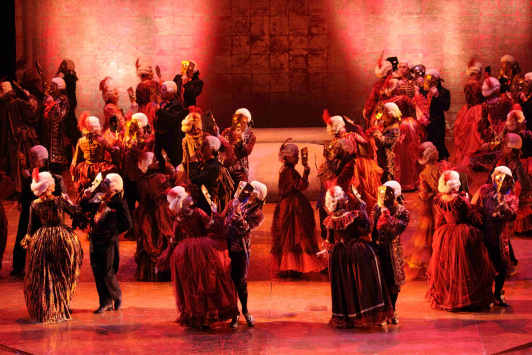Other Links
Editorial Board
-
Editor - Bill Kenny
-
Deputy Editor - Bob Briggs
Founder - Len Mullenger
Google Site Search
SEEN
AND HEARD INTERNATIONAL OPERA REVIEW
Verdi, Un ballo in maschera:
at the Estonian National Opera, Tallinn, 13.2.2009
(Premiere) (GF)
Stage Director: Arne Mikk
Designer: Ralf Forsström
Choreographer: Oksana Titova
Lighting Designer: Neeme Jóe
Cast:
King – Senol Talinli
Prime Minister – Rauno Elp
Amelia, his wife – Heli Veskus
Ulrica – Riina Airenne
Oscar – Angelika Mikk
Silvano – René Soom
Ribbing – Priit Volmer
Horn – Mart Laur
Chief Justice – Andres Köster
Amelia’s Servant – Georg Gurjev
Dance Soloists – Seili Loorits-Kämbre, Daniel Kirspuu,
Vadim Mjagkov
Estonian National Opera Chorus and Orchestra / Arvo
Volmer

In the new Estonian production there are several
anomalies concerning the central characters. There is
a king all right but nowhere referred to as Gustavus
III and his close friend, Amelia’s husband, is
plainly the Prime Minster. What is sung is however
the Boston version, where the ‘king’ and the ‘prime
minister’ are called Riccardo and Renato. This
curious mix is further enhanced by the atypical
costumes. The king and his prime minister wear
ordinary suits of fairly modern cut – could be
interwar time but also 1950s to present day. The king
has a blue ribbon across his chest to give a hint
about his position. Ribbing and Horn, as well as
their plotters, are dressed in uniforms of roughly
the same time, the body guards seem to have been
hired from Securitas. Only Amelia wears period
costumes – apart from the final scene, the masked
ball, where everyone is in late 18th
century outfit.
During the orchestral prelude we encounter
centre-stage a gigantic death-mask, which is divided
in two halves when the play begins, and moved to the
extreme left and right where they remain during the
performance as a reminder of the tragic end. A
similar mask, gilded, also functions as a backstage
door in the first scene. There is a lot of evocative
sets and lighting in this production. Ulrica’s
dwelling is lit in green and lilac and the concluding
ball scene with beautiful crinolines in purple and
skilful choreography is a feast for the eye. I was
slightly amused by the two chairs in the scene at the
Prime Minister’s place: rather kitschy with red
heart-shaped backs. Are they, I wondered, symbols for
the happiness that had been ruined by the Prime
Minister’s insight that his wife was having an affair
with the king? All in all however this is a truly
beautiful production.
I had a slight feeling that everything was not fully
settled with the acting at the premiere. Somehow it
seemed that the actors sometimes were not quite sure
where to stand, how to stand, when and where to move.
It seemed partly improvised. I’m sure this will be
sorted out during the following performances. There
was no mistaking though that the whole cast was well
inside their roles and sang and acted with deep
involvement.
As for the quality of the singing I had mixed
feelings. The Turkish tenor Senol Talinli was in
every respect superb as the King, acting naturally
and singing with a lightness and elegance that made
me think of Carlo Bergonzi in the role – and there
can be no higher praise. No less impressive was his
Amelia, Heli Veskus, who sported a large vibrant
voice with real spinto character and still able to
spin a beautiful inward pianissimo. Rauno Elp had the
dramatic intensity to make a powerful portrait of the
Prime Minister but as pure singing there was a lot to
be desired – at least during the first two acts:
strained and wobbly. Luckily he improved in the last
act and Eri tu became the highlight it rightly
should be. Angelika Mikk was a suitably glittering
Oscar but Riina Airenne’s Ulrica was terribly out of
sorts – though dramatically convincing. Priit Volmer
and Mart Laur impressed as Ribbing and Horn and the
excellent René Soom was luxury casting as Silvano.
I have heard quite a number of performances conducted
by Arvo Volmer and he never disappoints. This was a
truly dynamic reading with well judged tempos and as
usual loving care about the singers. I don’t think I
have ever heard the Estonian National Opera Orchestra
playing with such thrust and flair, obviously
relishing in the felicities and the melodic freshness
of Verdi’s score. The chorus were also well in the
picture. In the final scene there are also three
dancers dressed in virginal white and at the very
end, when the King is dead, Ulrica appears in an
elevated position at the back of the stage to confirm
that her prophecy has come true.
Despite some less than first class singing and the
somewhat diffuse attitude to the historical setting –
neither fish, flesh nor fowl in a way – this is
another valuable addition to the repertoire of the
Estonian National Opera.
Göran Forsling
Picture © Harri Rospu
Back
to Top
Cumulative
Index Page
